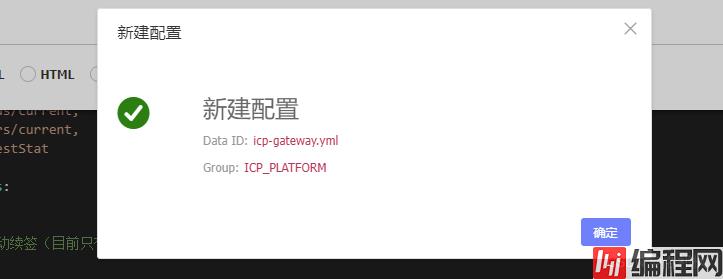Python 官方文档:入门教程 => 点击学习
目录一、前言二、在Nacos上创建配置文件创建配置文件配置说明发布并检查配置文件三、 修改项目配置与动态读取配置文件添加 nacos 动态配置依赖在controller与servic
使用动态配置的原因: properties 和 yaml 是写到项目中的,好多时候有些配置需要修改,每次修改就要重新启动项目,不仅增加了系统的不稳定性,也大大提高了维护成本,非常麻烦,且耗费时间。
使用动态配置,则可以避免这些麻烦,可以动态的修改配置,不需要重新启动项目。
nacos配置中心,可以使得配置标准化、格式统一化,当配置信息发生变动时,修改实时生效,无需要重新重启服务器,就能够自动感知相应的变化,并将新的变化统一发送到相应程序上,快速响应变化。
本次环境使用版本:NACOS1.4.2; spring-boot 2.3.9.RELEASE;nacos-config-spring-boot-starter 0.2.1
在默认命名空间中,创建一个配置文件

说明:
本次配置文件名称为 gateway.yml

注意: 项目启动时,nacos-config 会自动加载以下文件,故以下文件名称都可以作为默认动态配置的文件格式。
添加测试使用的配置 nacosConfigDemmo: NAME1

说明: 本次配置项目,分组名称为 ICP_PLATFORM (注意:分组名称建议使用下划线 _ ,不建议使用 中横线 - ,中横线会有几率出现不能读取的问题,使用连接符请注意使用;分组名可以自定,如果要区分命名空间,需要到 nacos 命名空间 中新建 命名空间)
编辑完成之后,直接点击发布,会提示新建完成

点击确定,然后点击返回配置中心,在配置列表中能找到自己的配置文件,确保文件内容正确即可

至此,配置文件完成,接下来在项目中使用这个配置文件。
在 pom.xml 文件中,添加依赖。
<dependency>
<groupId>com.alibaba.boot</groupId>
<artifactId>nacos-config-spring-boot-starter</artifactId>
<version>0.2.1</version>
</dependency>
修改项目配置文件,读取 nacos 中的配置内容
# 指定启动端口
server:
port: 7200
spring:
application:
# 指定服务名称
name: gateway
# 项目运行环境,可以搭配在 nacos 动态配置文件名上面,不同环境使用不同的动态配置
profiles:
active: dev
cloud:
nacos:
config:
server-addr: 127.0.0.1:8848 #nacos 的注册地址
file-extension: yml #动态配置文件的 格式。就是 nacos 中的动态配置,这里是 yml
group: ICP_PLATFORM #nacos 动态配置的分组,要与 nacos 配置文件保持一致
# namespace: #namespace 是nacos 的命名空间,我这儿是默认空间,就不配置了
controller 代码:
import com.insupro.search2.service.IIndexService;
import org.springframework.beans.factory.annotation.Autowired;
import org.springframework.WEB.bind.annotation.GetMapping;
import org.springframework.web.bind.annotation.RequestMapping;
import org.springframework.web.bind.annotation.RestController;
@RestController
@RequestMapping("/api/demo")
public class nacosConfigDemmo {
@Autowired
private DemoService demoService;
@GetMapping("/name")
public Object showDemoName(){
return demoService.showDemoName();
}
}service 接口代码:
public interface IIndexService {
Object showDemoName();
}
service 实现代码:
import com.insupro.search2.service.demoService;
import org.springframework.beans.factory.annotation.Value;
import org.springframework.cloud.context.config.annotation.RefreshScope;
import org.springframework.stereotype.Service;
@Service
// 注意,要自动刷新配置,需要 @RefreshScope 这个注解
@RefreshScope
public class demoServiceImpl implements demoService{
@Value("${nacosConfigDemmo}")
private String demoName;
@Override
public Object showDemoName(){
return demoName;
}
}运行,请求接口地址,得到响应值:
postman 请求,第一次响应,值为 NAME2

修改 nacos 配置文件,将 nacosConfigDemmo: NAME1 改为 nacosConfigDemmo: NAME2 并发布

等待控制台打印: Refresh keys changed: [nacosConfigDemmo],则动态配置已经生效

再次请求,发现返回值已经改变:

请求结果,NAME1 已经变成 NAME2,项目不需要重启,动态配置已经生效。
导入配置,网关不进行权限校验的路径
获取配置文件,生成 bean
import lombok.Getter;
import lombok.Setter;
import org.springframework.boot.context.properties.ConfigurationProperties;
import org.springframework.cloud.context.config.annotation.RefreshScope;
// 自动刷新机制,需要 get 方法支撑
@Setter
@Getter
// 获取配置文件
@ConfigurationProperties(prefix = "security.ignore")
// 开启自动刷新
@RefreshScope
public class SecurityProperties {
private PermitProperties ignore = new PermitProperties();
}配置文件实体类
import lombok.Getter;
import lombok.Setter;
@Setter
@Getter
public class PermitProperties {
private String[] HttpUrls = {};
public String[] getUrls() {
if (httpUrls == null || httpUrls.length == 0) {
return new ArrayList<>();
}
List<String> list = new ArrayList<>();
for (String url : httpUrls) {
list.add(url);
}
return list.toArray(new String[list.size()]);
}
}至此,导入自动配置完成,可以根据自己的业务代码进行网关的配置与使用。
但是!!注意!! 如果在配置文件中调用配置,则需要在配置文件中使用 @RefreshScope 注解,用于刷新配置。因为配置文件在项目启动时便已经完成加载。
例如:
@Configuration
public class ResourceServerConfiguration {
@Autowired
private SecurityProperties securityProperties;
// 使用了 @Configuration 定义配置文件,并在配置类中使用 @Bean 装配 bean,此时如果在自动装配出没有使用 @RefreshScope 注解,则自动配置不会生效。
@Bean
@Autowired(required = false)
@RefreshScope
SecurityWebFilterChain springSecurityFilterChain(Serverhttpsecurity http) {
if (securityProperties.getIgnore().getUrls().length > 0) {
authorizeExchange.pathMatchers(securityProperties.getIgnore().getUrls()).permitAll();
}
// TODO 余下自行业务代码 …………
return http.build();
}
}到此这篇关于Java nacos动态配置实现流程详解的文章就介绍到这了,更多相关Java nacos动态配置内容请搜索编程网以前的文章或继续浏览下面的相关文章希望大家以后多多支持编程网!
--结束END--
本文标题: Java nacos动态配置实现流程详解
本文链接: https://lsjlt.com/news/166644.html(转载时请注明来源链接)
有问题或投稿请发送至: 邮箱/279061341@qq.com QQ/279061341
2024-03-01
2024-03-01
2024-03-01
2024-02-29
2024-02-29
2024-02-29
2024-02-29
2024-02-29
2024-02-29
2024-02-29
回答
回答
回答
回答
回答
回答
回答
回答
回答
回答
0